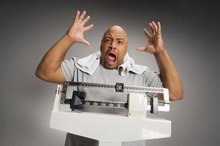The Ideal Weight for a Ballerina
The ideal weight for a ballerina depends on the ballet company and the individual ballerina. Ballet has attempted to move in a more modern and sensitive direction by accepting larger dancers, but there is still a certain body type that is considered most appealing on the stage.
Proportions
A classic ballerina body will ideally have very specific proportions -- long, slender arms and legs with a small head, long neck and a short torso. This body shape is considered optimal for creating lovely lines and expressive movements on stage.
Height
How to Tell If Your Legs Are Mostly Muscle or Fat
Learn More
Your height plays a significant role in determining your ideal weight. Most ballerinas are between about 5 foot 3 inches and 5 foot 8 inches tall. With this height range, weight is ideally anywhere between about 85 and 130 lbs., and depends heavily on muscle and bone mass.
Build
Ballerinas are expected to have a rather masculine but elegant shape with broad shoulders, small hips, small breasts and buttocks. The idea is to have the body create straight lines and smooth curves while dancing. Women have more fat tissue than men because of breasts and fatty tissue around the hips and buttocks, but since ballerinas are expected to have a less feminine shape, their weight may be slightly less than that for the average woman.
Should-to-Hip Ratio
Do You Lose Pounds or Inches First?
Learn More
Both male and female ballet dancers are expected to have a very high shoulder-to-hip ratio, meaning that the shoulders should be wider than the hips. This ratio affects the structure and density of the skeleton, so has a bearing on your weight. This kind of build is valued more highly than being a specific weight.
Muscle vs. Fat
Ballet is strenuous and is extremely demanding on the body. As such, a ballerina will build up a considerable amount of muscle, especially in the legs and arms. Muscle is denser than fat, so a muscular ballerina may weigh a bit more. If you have been working seriously for many years as a dancer, you may weigh more.
- Ballet is strenuous and is extremely demanding on the body.
- Muscle is denser than fat, so a muscular ballerina may weigh a bit more.
Considerations
The most important consideration when it comes to the ideal weight of a ballerina is whether your weight is healthy for you and your frame. The body needs certain nutrients, especially if it is expected to perform the rigorous exercise that is ballet dancing. If the body is not provided with these nutrients, it will eventually break as in the sad case of Heidi Guenther, a prima ballerina of the Boston Ballet, who died in 1997 from heart failure after being ordered to lose weight by her artistic director. Weighing only 93 lbs. at her death, Heidi used laxatives and turned to binging and purging to reach what was considered an ideal weight for a ballerina. The bottom line is that no career or hobby is worth risking your health for, so if you find that you are not the ideal weight for a ballerina, you shouldn't go to drastic measures to change that. Work on your technique, which is far more important than weight, and keep on dancing.
- The most important consideration when it comes to the ideal weight of a ballerina is whether your weight is healthy for you and your frame.
- The bottom line is that no career or hobby is worth risking your health for, so if you find that you are not the ideal weight for a ballerina, you shouldn't go to drastic measures to change that.
Related Articles
References
- San Francisco Chronicle: Heidi Guenther's Short, Tragic Life
- "The Ballet Companion"; Eliza Gaynor Minden; 2005
- Senna. Medline Plus. The National Institutes of Health, National Library of Medicine.
- Chinese Mallow. Therapeutic Research Center. Natural Medicines Database.
- Senna. Therapeutic Research Center. Natural Medicines Database.
Writer Bio
Lynette DiPalma has 12 years of writing experience with various publications, ranging from novels to magazines to poetry. She is a full-time freelance writer and artist, specializing in wedding-related articles. She also holds a license in couples counseling focusing on holistic practices. DiPalma has Master of Arts in English from Eastern New Mexico University.









